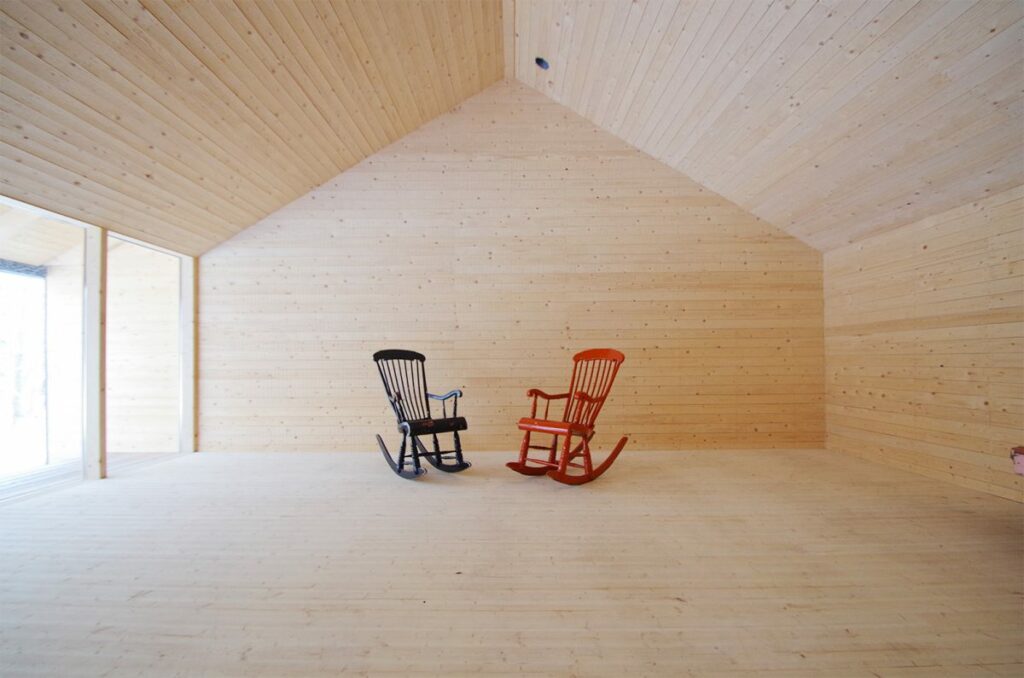Puuhi Community Space Featured in ARK Magazine

The Puuhi Community Space by OOPEAA is featured in the ARK Magazine issue 1 / 2020. Puuhi is a space for meetings and shared activity for the people of Soini. It is a place for gatherings and events initiated by the villagers and created to meet the needs of the community. Social and ecological sustainability were key principles guiding the design of Puuhi. The goal was to create a wooden building of high architectural quality using local materials and drawing from local skills and resources. Kyläpääskyt, an association founded by the local community, wanted Anssi Lassila, founder and director of OOPEAA, a native of Soini himself, to take on the task of designing it.
Even if the building itself is small, it is of great significance to the villagers. It provides them with a place in which to come together to celebrate the rich culture and talent of the community. It offers a space that suits a varied range of activities from informal gatherings to performances of music, theater and art.
In Puuhi, the desire for creating a shared space for the community merges with the view of the architect. The seamless collaboration between the architect, the client and the builder were essential in achieving a successful final result. In the design process, only hand drawn sketches were made in addition to the legal drawings required for the building permit. From start to finish, the design evolved organically through a series of discussions between the architect and a skilled local builder, Aki Alatalo. The design and building phase proceeded in stages over a two-year span adjusting to the rhythm of the seasons. As the design progressed, it was flexibly modified in response to the arising needs and in accordance to the availability of materials.
The entire project was realized with a very small budget and a lot of the materials used were received as donations and recycled from local sources. For example, the stones used for the foundation are recycled from a burnt down school in the nearby Hautakylä village, and the stairs of the terrace are made of larch trees felled from the yard of the old vicarage saved from being turned into firewood and donated to the project by the architect himself.
Puuhi is located on a small farm with some fields and a little bit of forest land around it near the Lake IIroo in Soini in the Finnish Ostrobothnia. There was a croft from the late 19thcentury as well as a sauna on the lot. As part of the project for building a new house for the community, the old red croft was partially restored with volunteer labor. However, it was not possible to repair the sauna anymore, and the new Puuhi building was built in its place. The dark, sculpted shape of the new Puuhi building stands in stark contrast to the old red croft. The form language of Puuhi draws from the local tradition of building that is characterized by a sense of modesty and pride. Together the old red croft and the new Puuhi building form a place that lends itself to a broad range of different kinds of activity.
The name of the house, Puuhi, refers both to the word used in the local dialect in the northern Ostrobothnia for a drying barn as well as to the purpose of the building as a place of many activities (puuha = activity). Puuhi is like a large farm shed. To accommodate the many different uses of the building, the interior is realized as one completely open space with no dividing walls. The high ceilings of the wooden building provide for excellent acoustics and suit very well for concerts and performances. The veranda and the yard extend the space available for events. There is also a storage space for storing benches and other supplies.
The wooden surfaces of the building have deliberately been left untreated and the texture of the spruce planks sawn by hand has been left visible in the interior walls. A light layer of anti-molding agent was used in the wall boarding and the floor was rubbed with tall oil soap to keep dirt from sticking to it. For consistency, the interior walls of the veranda were made of the same hand-sawn spruce planks as the interior walls. The roof, in turn, was covered with the same kind of spruce boarding as the exterior walls, and both were tarred black.
Puuhi is an off-grid building with no electricity. The wooden house has been intentionally designed so that in it can be kept cold in the wintertime when not in use and can then easily be heated with a stove when there are activities there. The large front window on the long wall of the building opens to the yard giving the interior space a lot of light and creating a seamless connection between the interior and the exterior.
For a fuller description of Puuhi, see HERE.